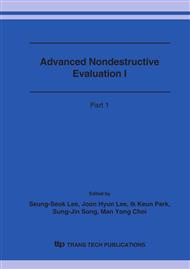[1]
T.A. Collings: Composites Vol. 1 (1977), p.43.
Google Scholar
[2]
W.J. Quinn, F.L. Matthews: J Comp. Mater. Vol. 11 (1977), p.139.
Google Scholar
[3]
T.A. Collings: Composites Vol. 7 (1982), p.241.
Google Scholar
[4]
G. Kretsis and F.L. Matthews: Comoisites Vol. 16-2 (1985), p.92.
Google Scholar
[5]
P.P. Camanho and F.L. Matthews: a review, Composites Vol. 28-A (1997), p.529.
Google Scholar
[6]
K.J. Lodge: Composites Vol. 7 (1982), p.305.
Google Scholar
[7]
K. Moriya and T. Endo: Aeronautical and Space Japan Vol. 36-410 (1988), p.139 [in Japanese].
Google Scholar
[8]
K. Schulte and C. Baron: Comp. Sci. & Tech. Vol. 36 (1989), p.63.
Google Scholar
[9]
N. Muto, H. Yanagida, M. Miyayama, T. Nakatsuji, M. Sugiya and Y. Ohtsuka: Japan Society Composites Materials Vol. 18-4 (1992), p.144 [in Japanese].
Google Scholar
[10]
C. Fischer and F.J. Arendts: Comp. Sci. & Tech. Vol. 46 (1993), p.319.
Google Scholar
[11]
P.W. Chen and D.D.L. Chung: Smart Mater. Struct. Vol. 2 (1993), p.22.
Google Scholar
[12]
A.S. Kaddoour, F.A. Al-Salehi and S.T.S. Al-Hassani: Comp. Sci. & Tech. Vol. 51 (1994), p.377.
Google Scholar
[13]
C. Wolfige and K. Drechsier: Advanced Materials for Lightweight Structures, ESTEC (1994), p.677.
Google Scholar
[14]
P.W. Chen and D.D. L Chung: J Am. Ceram. Soc. Vol. 78-3 (1995), p.816.
Google Scholar
[15]
X. Wang and D.D. L Chung: Polymer Composites Vol. 18-6 (1997), p.692.
Google Scholar
[16]
P.E. Irving and C. Smart Mater. & Struct. Vol. 7 (1998), p.456.
Google Scholar
[17]
J.C. Abry, S. Bochard and A. Chateauminois: Comp. Sci. & Tech. Vol. 59 (1999), p.925.
Google Scholar
[18]
D.C. Seo and J.J. Lee: Composites Structures Vol. 47 (1999), p.525.
Google Scholar
[19]
J.C. Abry, Y.K. Choi and A. Chateuminois: Comp. Sci. & Tech. Vol. 61 (2001), p.855.
Google Scholar
[20]
I. Weber and P. Schwartz: Comp. Sci. & Tech. Vol. 61 (2001), p.849.
Google Scholar
[21]
N. Muto, Y. Arai, S.G. Shin and H. Matsubara: Composites: Comp. Sci. & Tech. Vol. 61 (2001), p.875.
Google Scholar
[22]
M. Kupke, K. Schulte and R. Schuler: Comp. Sci. & Tech. Vol. 61 (2001), p.837.
Google Scholar
[23]
R. Schueler, S.P. Joshi and K. Schulte: Comp. Sci. & Tech. Vol. 61 (2001), p.921.
Google Scholar
[24]
S. Kubo, M. Kuchinishi, T. Sakagami and S. Ioka: Applied Electromagnetics and Mechanics, Takagi T, Uesaka M, editor. Proc. of the 10th Int. Symp. (2001), p.641.
Google Scholar
[25]
X. Luo and D.D.L. Chung: Polym. Eng. Sci. Vol. 20-7 (2000), p.1505.
Google Scholar
[26]
A. Todoroki, Y. Tanaka and Y. Shimamura: Technomic, Chang FK, editor. Structural health monitoring 2000, Lancaster: (1999).
Google Scholar
[27]
A. Todoroki, Y. Tanaka and Y. Shimamura: Materials Science Research International, JSMS (2001), p.139.
Google Scholar
[28]
A. Todoroki, M. Tanaka and Y. Shimamura: Comp. Sci. & Tech. Vol. 62 (2002), p.619.
Google Scholar
[29]
A. Todoroki, Y. Tanaka and Y. Shimamura: Comp. Sci. & Tech. Vol. 62 (2002), p.1151.
Google Scholar
[30]
A. Todoroki, M. Tanaka, Y. Shimamura and H. Kobayashi: Adv. Comp. Mat. Vol. 13-2 (2004), p.107.
Google Scholar
[31]
A. Todoroki: Key Eng. Mat. Vol. 270-273 (2004), p.1812.
Google Scholar
[32]
M. Ueda, A. Todoroki and Y. Shimamura: Key Eng. Mat. Vol. 270-273 (2004), p. (1935).
Google Scholar
[33]
Y. Shimamura, K. Oda, A. Todoroki and H. Kobayashi: Design, Manufacturing and Applications of Composites, 5 th Joint Canada-Japan Workshop on Composites (2004), p.416.
Google Scholar
[34]
A. Todoroki, M. Tanaka, Y. Shimamura, Compos. Sci. Technol. Vol. 65(1) (2005), p.33.
Google Scholar
[35]
Y. Shimamura, K. Oda, A. Todoroki and H. Kobayashi, T. Inada: Key Eng. Mat. Vol. 297-300 (2005), p.653.
Google Scholar
[36]
K. Omagari, A. Todoroki, Y. Shimamura, H. Kobayashi, Key Eng, Mat. Vol. 297-300 (2005) p. (2096).
Google Scholar


